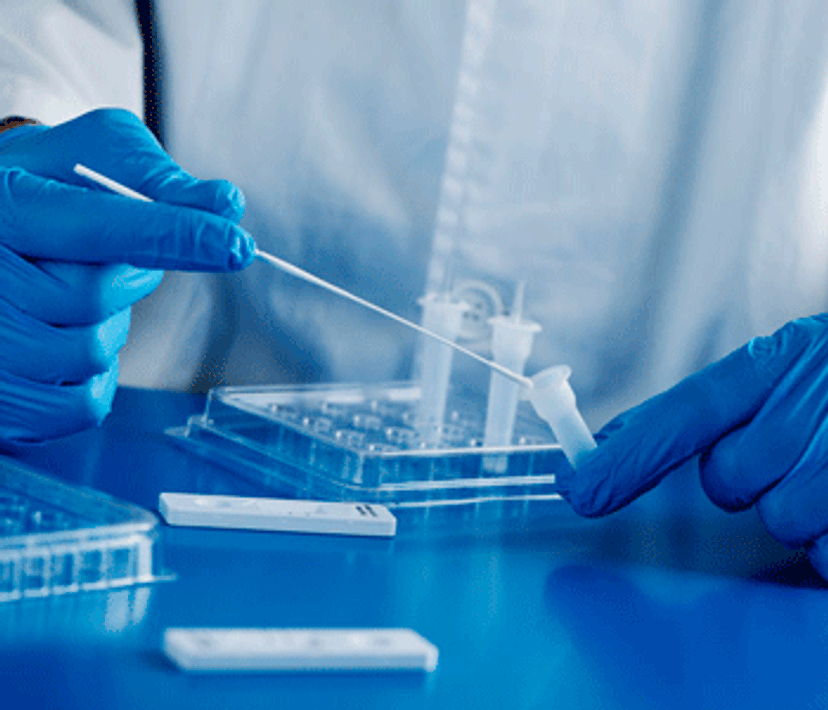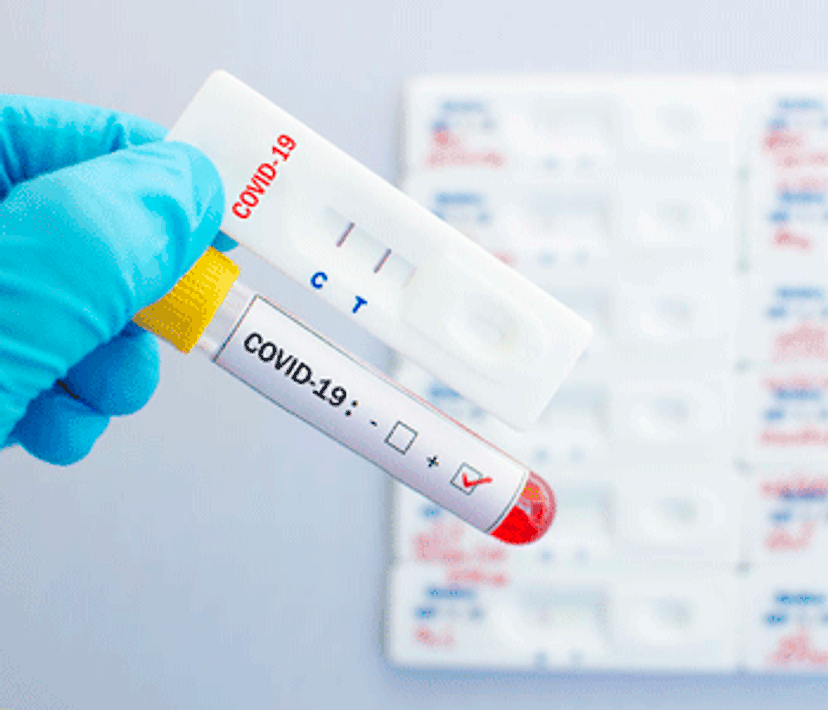Supporting the first line of defense in a pandemic
Lateral flow assays are empowering the fight against COVID-19 and in this article, experts in the field tell us more about this technology, highlighting recent advances and challenges
29 Mar 2021

Lateral flow testing for COVID-19 detection offers significant timesaving and point-of-care advantages compared to other detection methods Nito500 © 123RF.com
As 2020 came to a close and we cheered on our resilient healthcare workers and innovative vaccine experts from around the globe, reports of new COVID-19 variants were already surfacing to serve as a staunch reminder of the importance of continued tracing and quarantine efforts. Rapid testing and detecting population immunity remain vital to control the pandemic spread. To overcome the inevitability of long waits and the need for professional testing expertise, lateral flow immunoassays are being developed and distributed to allow the public to take testing into their own hands. To meet the surge in demand caused by the pandemic despite disrupted supply chains, diagnostic leaders such as MilliporeSigma are thinking innovatively to future-proof their systems in the lateral flow assay development lifecycle.
Rapid tests to detect COVID-19 using lateral flow technology
Lateral flow assays work on the principle of detecting antibodies against foreign proteins, such as antigens from a virus, in the human sample being tested. One of the main advantages of these tests is that they are easy to use, evidenced in the widespread use of home pregnancy tests based on the same technology. “Lateral flow tests are user friendly. You don’t need experienced lab technicians to run the tests,” says Katie O’Brien, R&D scientist, at the Merck KGaA, Darmstadt, Germany Diagnostic Solutions Group based in Cork, Ireland. The tests can also be manufactured at a large scale and run in a cost-effective manner, such as in domestic settings, versus other immunoassays such as ELISA. When compared with RT-PCR – considered as the gold standard for COVID-19 detection – lateral flow assays may not be as sensitive, but they offer a significant timesaving and point-of-care advantage. As Dr. Eileen Hannigan, senior scientist at Merck KGaA, puts it: “In point-of-care applications, speed is a critical parameter. Using lateral flow testing, you can get results in less than 10 minutes.”
As lateral flow tests can be designed to detect specific types of antibodies, they can discern IgM antibodies for acute infections from IgG antibodies for longer-term infections. This is crucial for potentially detecting not just symptomatic, but also asymptomatic people who have cleared the virus. With such obvious benefits to using lateral flow assays, the Merck KGaA team is currently providing the ingredients to develop lateral flow assays while also continuously optimizing methods to improve these materials. The team is currently focused on resolving assay preparation challenges such as improving test sensitivity by using europium in place of colloidal particles, preventing detection failures by reducing buffer propensity to denature proteins of interest and developing reference tests to reliably measure kit performance.
Beyond the R&D phase, the rapid diagnostics field also faces challenges in manufacturing and distribution. Even prior to the pandemic, lateral flow tests were a popular product. The core membranes and ancillary reagents such as antibodies, surfactants, detergents, buffers and detector particles determine performance for each of these test kits.
Overcoming manufacturing challenges during the pandemic
“All of these raw materials are sourced in very different ways,” explains Shawn Gaskell, Head of Diagnostic Manufacturing Materials. “Increasing biological capacities can take years as a result of important regulations and the inherent challenges associated with the process.” Being cognizant of such requirements as a major player in the field, MilliporeSigma had started plans to expand capacity prior to COVID-19. However, the pandemic-imposed construction restrictions, social-distancing-mandated limitations and knowledge transfer delays meant that production plans such as increasing membrane volumes by 2021 have had to be re-adjusted. Gaskell notes that practical thinking and building flexibility into systems has been the MilliporeSigma way to overcome these unpredictable challenges.
The surging demand and supply chain challenges are still directly indicative of the advantages that make these tests popular. This is unlikely to change as countries worldwide gear up for vaccines to arrive and be distributed. Dr. Michael Mansfield, Applications Development Scientist, MilliporeSigma asserts: “Where I see lateral flow tests having a lot of utility is when large-scale vaccinations begin. These tests will help to confirm whether the vaccine has taken hold by determining the presence of circulating antibodies for the virus in the bloodstream.”
With production technology evolving and the kits constantly being optimized, it remains imperative to maintain a lot-to-lot consistency. The quality of raw materials going into the kit, especially that of critical ones which cannot be substituted without validation, hugely determines assay performance.
Consistency, quality and reliability – the future of lateral flow assays

Robust supply chains and high-quality raw materials are key to meeting the demands for lateral flow assays during the COVID-19 pandemic Jarun Ontakrai © 123RF.com
As Mary Saunders, product manager, MilliporeSigma, describes it: “Critical raw materials are the building blocks of a good assay. This is even more important in in vitro assays where the outcome directly impacts a patient.” Therefore, the MilliporeSigma team strongly believes in using raw materials with a stable shelf life, ensuring robust supply chains and proactively discussing long-term demands with its manufacturing partners. This approach has remained unchanged during the pandemic as well. Terri Borree, portfolio manager and co-worker to Saunders, elaborates: “At MilliporeSigma, we consider diagnostic assay manufacturers as partners rather than as customers. Customers trust us by sharing their assay details and we repay this by investing our time in directing them to the best product configuration.”
Prioritizing customer needs, MilliporeSigma offers products throughout the lateral flow assay development lifecycle. Facilities in the U.S., the U.K. and Ireland offer custom antibody production services, while the company distributes a host of critical raw material types for developing and manufacturing diagnostic kits worldwide. For customers needing assay development and production assistance, MilliporeSigma’s larger diagnostic group also offers unique OEM contract manufacturing and diagnostic solutions along with kit assembly services.
As product portfolio manager Katie Spitere states, “COVID-19 has reaffirmed the critical need for high-quality, sensitive and reliable diagnostic tests. MilliporeSigma delivers high quality in terms of product, service and technical support.” Rapid diagnostics are having to evolve to keep pace with platform technologies and increasing demands. Borree predicts that there will be a large push for lateral flow assays and similar technologies to deliver higher specificity and sensitivity, with reduced reagent volumes and shorter detection times. Therefore, current MilliporeSigma priorities of establishing symbiotic R&D and manufacturing collaborations, adopting flexible and pragmatic system design, as well as providing high-quality raw materials and optimized formulation insights, are the way forward for the foreseeable future.
Poised with cutting-edge knowledge and skills in the latest technologies, MilliporeSigma and its scientists are dedicated to continuously future-proofing their specialized life science portfolio. For more information on MilliporeSigma products that are helping meet demands for lateral flow assay requirements during the COVID-19 pandemic and enabling impactful rapid diagnostic manufacturers, check out these related articles:
- COVID-19 testing using lateral flow assays: sensitive, rapid, easy to use and point-of-care
- Dealing with unpredictability: Manufacturing COVID-19 lateral flow tests during the pandemic
- Consistency and quality in raw materials: Building blocks of a reliable in vitro assay
Request a free sample pack to see how Hi-Flow™ Plus membranes can enhance your tests.

